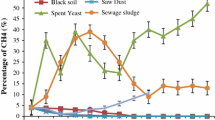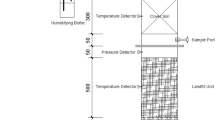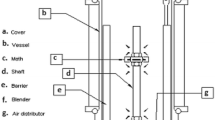Abstract
Volatile sulfur compounds are the main odorants at landfills. In this study, methanethiol (CH3SH) was chosen as a typical volatile organic sulfur compound, and its generation potential was investigated during the anaerobic degradation of the organic fractions of municipal solid waste (MSW) including rice, flour food, vegetable, fish and pork, paper, cellulose textile, and yard wastes. Among the experimental wastes, gas generation was the highest in the fish and pork waste with a high CH3SH concentration of up to 2.5% (v/v). Sulfur reduction in the solid phase was mostly converted into gaseous sulfur compounds. During the whole experiment, the cumulative CH3SH generation from the fish and pork waste was 0.139 L kgdw −1, which was about 2 and 6 orders of magnitude higher than that from the other experimental wastes. The ratio of CH3SH-S to TS reduction was 31.56% in the fish and pork waste. These results would be helpful to understand the generation of volatile sulfur compounds during the anaerobic degradation of MSW and develop techniques to control odor pollution at landfills.




Similar content being viewed by others
References
Abdul-Wahab SA, Al-Hajri A, Yetilmezsoy K (2016) Impact of the ambient air quality due to the dispersion of non-methane organic compounds from Barka Landfill. Int J Environ Sci Technol 13:1099–1108
Bao SD (2000) Soil agro-chemistry analysis. Chinese Agriculture Press, Bei**g (In Chinese)
Chasteen TG, Bentley R (2004) Volatile organic sulfur compounds of environmental interest: dimethyl sulfide and methanethiol. J Chem Educ 81:1524–1528
Cho JK, Park SC (1995) Biochemical methane potential and solid-state anaerobic-digestion of Korean food wastes. Bioresour Technol 52:245–253
De Bruyn WJ, Swartz E, Hu HJ, Shorter JA, Davidovits P, Worsnop DR, Zahniser MS, Kolb CE (1995) Henry’s law solubilities and Śetchenow coefficients for biogenic reduced sulfur species obtained from gas-liquid uptake measurements. J Geophys Res 100:7245–7251
Derbali E, Makhlouf J, Vezina LP (1998) Biosynthesis of sulfur volatile compounds in broccoli seedlings stored under anaerobic conditions. Postharvest Biol Technol 13:191–204
Ding Y, Cai C, Hu B, Xu Y, Zheng X, Chen Y, Wu W (2012) Characterization and control of odorous gases at a landfill site: a case study in Hangzhou, China. Waste Manag 32:317–326
Fang JJ, Yang N, Cen DY, Shao LM, He PJ (2012) Odor compounds from different sources of landfill: characterization and source identification. Waste Manag 32:1401–1410
Faour AA, Reinhart D, You H (2007) First-order kinetic gas generation model parameters for wet landfills. Waste Manag 27:946–953
Finkelstein A, Benevenga AJ (1986) The effect of methanethiol and methionine toxicity on the activities of cytochrome c oxidase and enzymes involved in protection from peroxidative damage. J Nutr 116:204–215
Glindemann D, Novak JT, Murthy SN, Gerwin S, Forbes R, Higgins M (2004) Standardized biosolids incubation, headspace odor measurement and odor production consumption cycles. In: Proceedings Water Environment Federation and AWWA Odors and Air Emissions Conference. Bellevue, Washington
He R, Wang J, **a FF, Mao LJ, Shen DS (2012a) Evaluation of methane oxidation activity in waste biocover soil during landfill stabilization. Chemosphere 89:672–679
He R, **a FF, Bai Y, Wang J, Shen DS (2012b) Mechanism of H2S removal during landfill stabilization in waste biocover soil, an alternative landfill cover. J Hazard Mater 217-218:67–75
Herbert RA, Hendrie MS, Gibson DM, Shewan JM (1971) Bacteria active in the spoilage of certain sea foods. J Appl Microbiol 34:41–50
Kadota H, Ishida Y (1972) Production of volatile sulfur compounds by microorganisms. Annu Rev Microbiol 26:127–138
Kim KH (2006) Emissions of reduced sulfur compounds (RSC) as a landfill gas (LFG): a comparative study of young and old landfill facilities. Atmos Environ 40:6567–6578
Kim KH, Choi YJ, Jeon EC, Sunwoo Y (2005) Characterization of malodorous sulfur compounds in landfill gas. Atmos Environ 39:1103–1112
Lee CL, Brimblecombe P (2016) Anthropogenic contributions to global carbonyl sulfide, carbon disulfide and organosulfides fluxes. Earth Sci Rev 160:1–18
Lee DH, Behera SK, Kim J, Park HS (2009) Methane production potential of leachate generated from Korean food waste recycling facilities: a lab scale study. Waste Manag 29:876–882
Li XL, Rezaei RZ, Li P, Wu GY (2011) Composition of amino acids in feed ingredients for animal diets. Amino Acids 40:1159–1168
Liu XJ, Li H, Xue JH, Niu X, Wei P (2011) Study on biogas production using anaerobic fermentation of rice straw. Agric Sci Technol 12:1761–1764
Muezzinoglu A (2003) A study of volatile organic sulfur emissions causing urban odors. Chemosphere 51:245–252
National Bureau of Statistics of the People’s Republic of China (NBS) (2016) China statistical yearbook 2015. China Statistics Press, Bei**g (In Chinese)
Nielfa A, Cano R, Vinot M, Fernández E, Fdz-Polanco M (2015) Anaerobic digestion modeling of the main components of organic fraction of municipal solid waste. Process Saf Environ Prot 94:180–187
Ogura T, Hoshino R, Date Y, Kikuchi J (2016) Visualization of microfloral metabolism for marine waste recycling. Meta 6:1–10
Schäfer H, Myronova N, Boden R (2010) Microbial degradation of dimethylsulphide and related C1-sulphur compounds: organisms and pathways controlling fluxes of sulphur in the biosphere. J Exp Bot 61:315–334
Smet E, Lens P, Van Langenhove H (1998) Treatment of waste gases contaminated with odorous sulfur compounds. Crit Rev Environ Sci Technol 28:89–117
Steinfeld G, Sanderson R (1998) Landfill gas cleanup for carbonate fuel cell power generation. CRADA final report, Office of Scientific Technical Information Technical Reports
Tangerman A (2009) Measurement and biological significance of the volatile sulfur compounds hydrogen sulfide, methanethiol and dimethyl sulfide in various biological matrices. J Chromatogr B 877:3366–3377
Tiquia SM, Wan JHC, Tam NF (2002) Dynamics of yard trimmings composting as determined by dehydrogenase activity, ATP content, arginine ammonification, and nitrification potential. Process Biochem 37:1057–1065
USDHHS (2007) Health Consultation—air quality hydrogen sulfide in ambient air near Saufley field construction and demolition debris landfill. U.S. Department of Health and Human Services. http://www.atsdr.cdc.gov/HAC/pha/SaufleyFieldConstruction/SaufleyFieldHC080107.pdf
Visco G, Campanella L, Nobili V (2004) Organic carbons and TOC in waters: an overview of the international norm for its measurements. Microchem J 7:185–191
Waller RL (1977) Methanethiol inhibition of mitochondrial respiration. Toxicol Appl Pharmacol 42:111–117
**a FF, Su Y, Wei XM, He YH, Wu ZC, Ghulam A, He R (2014) Diversity and activity of sulphur-oxidizing bacteria and sulphate-reducing bacteria in landfill cover soils. Lett Appl Microbiol 59:26–34
Yue D, Han B, Sun Y, Yang T (2014) Sulfide emissions from different areas of a municipal solid waste landfill in China. Waste Manag 34:1041–1044
Zheng LJ, Song JC, Li CY, Gao YG, Geng PL, Qu BN, Lin LY (2014) Preferential policies promote municipal solid waste (MSW) to energy in China: current status and prospects. Renew Sust Energ Rev 36:135–148
Zou SC, Lee SC, Chan CY, Ho KF, Wang XM, Chan LY, Zhang ZX (2003) Characterization of ambient volatile organic compounds at a landfill site in Guangzhou, South China. Chemosphere 51:1015–1022
Acknowledgements
This work was financially supported by the National Natural Science Foundation of China with Grants No. 41671245 and No.41371012, Zhejiang Province Key Research Project (2015C03021).
Author information
Authors and Affiliations
Corresponding author
Additional information
Responsible editor: Bingcai Pan
Electronic supplementary material
ESM 1
(DOCX 62 kb).
Rights and permissions
About this article
Cite this article
Chen, M., Yao, XZ., Ma, RC. et al. Methanethiol generation potential from anaerobic degradation of municipal solid waste in landfills. Environ Sci Pollut Res 24, 23992–24001 (2017). https://doi.org/10.1007/s11356-017-0035-x
Received:
Accepted:
Published:
Issue Date:
DOI: https://doi.org/10.1007/s11356-017-0035-x




